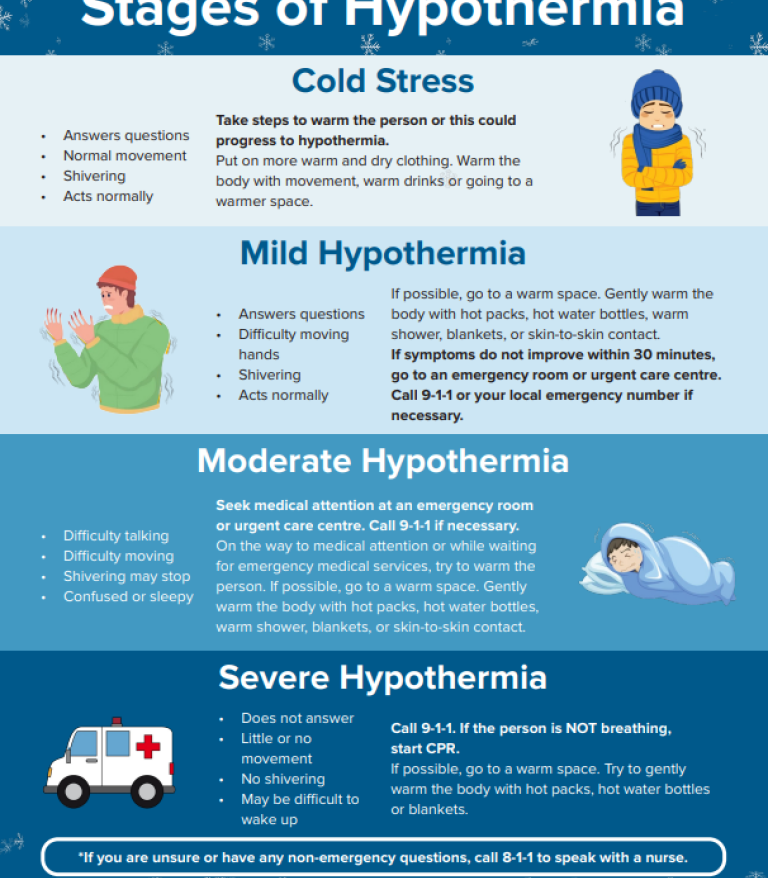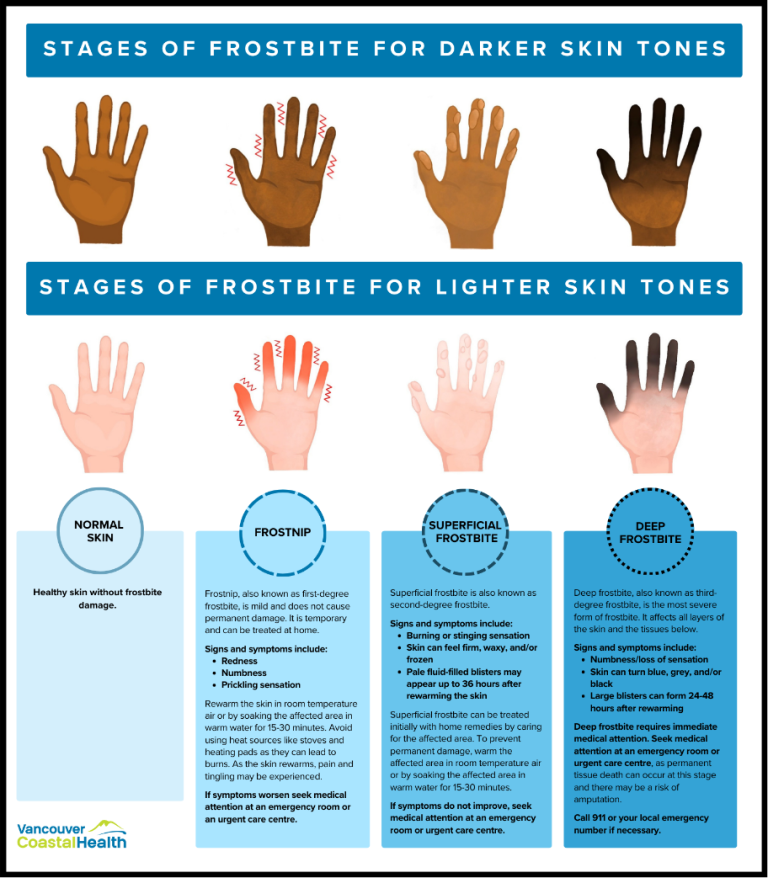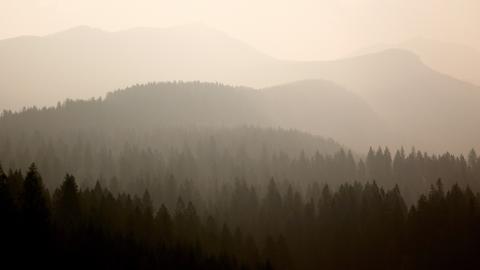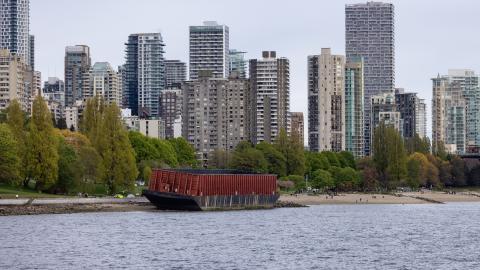Resource
Extreme cold
On this page
- Health issues during winter weather
- Hypothermia
- Frostbite
- Slips and falls
- Carbon monoxide (CO) poisoning
- People at higher risk
- Take safety precautions
- Winter care
- Mental health and substance use
- Daytime and overnight shelter options
- Winter weather warnings
- PreparedBC Severe Winter Weather and Storm Preparedness Guide
- Additional winter weather resources
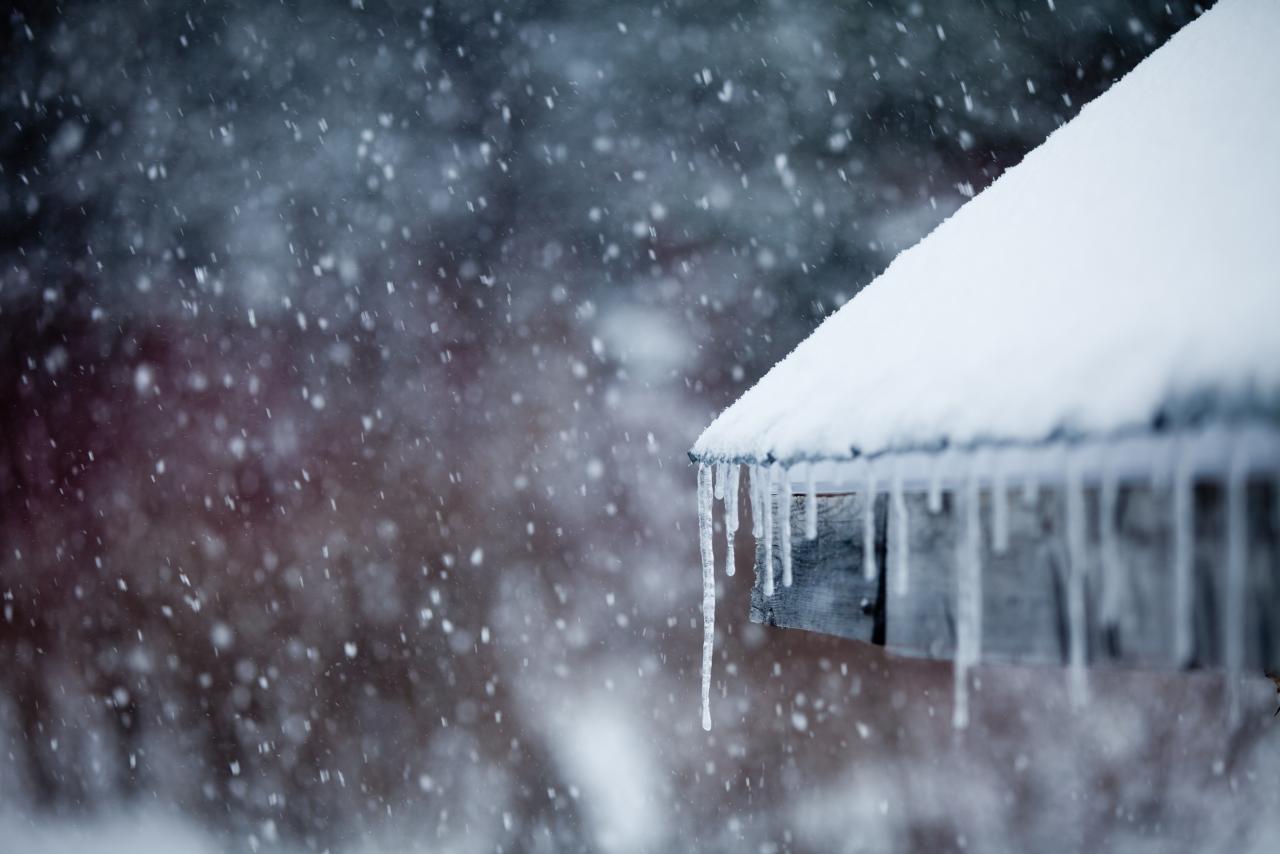
In extreme cold, there are increased risks of hypothermia, frostbite, slips, falls, carbon monoxide poisoning and potentially death. Winter weather can affect everyone's health, so make sure you're ready and do what you need to keep yourself, your family, and your community safe.
Health issues during winter weather
During winter weather, there are increased risks of hypothermia, frostbite, slips, falls, carbon monoxide poisoning and potentially death. The health effects of winter weather can impact anyone, so be prepared and take action when necessary.
Hypothermia
Hypothermia is caused by long exposures to cold temperatures, causing body temperature to drop. Low body temperature can cause confusion and difficulty moving and can have severe impacts, including organ failure and death.
Mild hypothermia
- Shivering
- Difficulty moving hands
If possible, go to a warm space. Gently warm the body with hot packs, hot water bottles, warm showers, blankets, or skin-to-skin contact (this may be particularly helpful for infants and young children). If symptoms do not improve within 30 minutes, visit an emergency room or urgent care centre. Call 9-1-1 or your local emergency number if necessary.
Moderate hypothermia
- Shivering may stop
- Difficulty moving hands or other parts of the body
- Difficulty talking
- Confused or sleepy
Seek medical attention at an emergency room or urgent care centre. Call 9-1-1 if necessary. On the way to medical attention or while waiting for emergency medical services, try to warm the person. If possible, go to a warm space. Gently warm the body with hot packs, hot water bottles, warm showers, blankets, or skin-to-skin contact.
Severe hypothermia
- No shivering
- Little or no movement
- Does not answer questions
- May be difficult to wake up
Call 9-1-1. If the person is not breathing, start CPR. If possible, go to a warm space. Try to gently warm the body with hot packs, hot water bottles or blankets.
If you are unsure or have any non-emergency questions, call 8-1-1 to speak with a nurse.
Frostbite
Frostbite occurs when skin freezes and can occur when skin is exposed to cold temperatures. In severe cases, frostbite may lead to amputation (the need to medically remove a body part). At the first signs of redness or pain in any skin area, protect any exposed skin and/or get out of the cold—frostbite may be beginning.
Frostnip (milder, without freezing of the skin)
- Redness
- Numbness
- Prickling sensation
To treat frostnip, rewarm the skin in room temperature air or by soaking the affected area in warm water for 15-30 minutes (thawing frostbitten skin is very painful so use water that is just above body temperature). Avoid using heat sources like stoves and heating pads as they can lead to burns. As the skin rewarms pain and tingling may be experienced. If symptoms worsen seek medical attention at an emergency room or an urgent care centre.
Superficial frostbite
- Burning or stinging sensation
- Skin can feel firm, waxy, and/or frozen
- Pale fluid-filled blisters may appear up to 36 hours after rewarming the skin
Superficial frostbite can be treated initially with home remedies by caring for the affected area. To prevent permanent damage, warm the affected area as described above. If symptoms do not improve, seek medical attention at an emergency room or urgent care centre.
Deep frostbite
- Numbness/loss of sensation
- Skin can turn blue, grey, and/or black
- Large blisters can form 24-48 hours after rewarming
Deep frostbite requires immediate medical attention. Seek medical attention at an emergency room or urgent care centre, as permanent tissue death can occur at this stage, and there may be a risk of amputation. Call 9-1-1 or your local emergency number if necessary.
Slips and falls
During periods of snow and ice, there is a greater risk for slips and falls outdoors. The number of people visiting the emergency department or being hospitalized due to slips and falls may increase during these times. Everyone, regardless of age and ability, can be at risk for falls. Falls are preventable with the right tools and preparation.
Tips to avoid slips and falls
- Plan ahead so you have enough time to get where you're going.
- Walk on cleared walkways if there is ice and snow on the ground.
- Use boots or shoes that fit well and have a thick, non-slip tread sole.
- Use a cane, ski poles or walking sticks to help with balance. If using a cane, attach a retractable ice pick to the end.
- Take short shuffling steps with your toes pointed slightly outward on slippery surfaces (like a penguin). Watch this winter walking video for more tips.
Carbon monoxide (CO) poisoning
During winter, carbon monoxide poisoning may occur more frequently as some heating systems burn fuel to keep spaces warm (e.g. gas heating, wood or charcoal stoves, oil, kerosene). Carbon monoxide poisoning occurs when people inhale too much carbon monoxide and can happen when appliances malfunction or are used in spaces without adequate ventilation (e.g., blocked chimneys, closed windows, or inside a tent). You cannot see, smell or taste carbon monoxide, but it can be deadly in minutes.
Learn the symptoms of carbon monoxide poisoning and prevention tips (HealthLink BC)

Dr. Bruce Campana, a hyperbaric physician at Vancouver General Hospital talks about the symptoms, sources, and risks of CO poisoning.
People at higher risk
Some people are at higher risk of experiencing health effects related to winter weather. While anyone not dressed warmly is at risk of negative health effects in winter weather conditions, some individuals are at greater risk than others. Steps to be aware of local winter weather conditions and effects and support for protective measures are especially important for the following groups:
Populations that are at higher risk of winter weather-related health effects include:
- People who are unhoused or insecurely housed
- People living in inadequate housing, such as inadequate insulation, electricity or heat (including those living in a state of energy or fuel poverty)
- People spending long periods of time outdoors (for work, recreation, or transportation)
- Older adults
- Infants and young children
- People with pre-existing health conditions, including conditions or diseases of the heart or lungs or health conditions that impact blood circulation (e.g. diabetes, or certain medications that constrict blood vessels)
- People who use substances, including alcohol
Take safety precautions
As winter arrives, members of the public are encouraged to take precautions.
At home
- Heat your home to at least 21℃ if infants or elderly people are present. During winter months, heating costs may increase. If you have difficulty paying for heat, consider exploring BC Hydro’s Energy Conservation Assistance Program and check if your city or town has a rent bank.
- Make a plan and prepare your home for winter hazards in your area. See the PreparedBC Guides for Winter Weather and Storms, Power Outages, Floods, Avalanches and other BC hazards.
- Build an emergency kit and restock it after each use. See the PreparedBC Home Preparedness Guide.
- Maintain public spaces outside of your home, including sidewalks and parking areas, as safe pathways for everyone's mobility.
- Learn snow shovelling tips to prevent injuries.
- Some communities have Snow Angels / Snow Stars programs to assist seniors or people with disabilities to clear snow off walkways. This can decrease injury risk and support people's mobility. Volunteers are always needed! Contact your local government or First Nation for more information.
Getting around outside
- Check the weather report before going outside. Plan a safe route with extra time to navigate winter conditions.
- Dress for winter weather:
- Wear layers, preferably with a waterproof or windproof outer layer. Take off layers as you heat up to avoid sweating. The risk of hypothermia increases when you or your clothes are wet.
- Choose wool or synthetic clothing, which keeps people warmer and dryer than cotton.
- Depending on the temperature and wind (wind chill), exposed skin can freeze in minutes. Wear a hat, scarf, mittens or gloves.
- Use boots or shoes that fit well, are insulated, waterproof, and have good traction. Consider wearing traction devices on footwear, but remember that they can be slippery on smooth surfaces like tiles.
- Wear bright and reflective clothing so vehicles can see you in the dark. Drivers should proceed cautiously, and visibility can increase safety for people walking, rolling or biking.
Driving
- Plan travel routes ahead of time so you have enough time to get where you’re going.
- Learn how to prepare your vehicle for winter driving. Check the snow tire and chain requirements for your area.
- Monitor up-to-date information on weather and transportation at Drive BC. You can also call toll-free 1-800-550-4997 for B.C. road information 24 hours a day.
During winter storms and extreme cold
- Check weather advisories from Environment and Climate Change Canada and emergency alerts from Emergency Info BC.
- Contact your Local Government or First Nation for community support.
- Know where to go for the right healthcare during winter months.
- Consider rescheduling activities or limiting time outdoors during colder temperatures.
- Check-in on your neighbours, friends and family, especially older adults or people with disabilities who live alone. Make sure they are keeping warm and check if they need supplies, transportation, assistance clearing snow or other support.
Winter care
This season, more than ever, it's vital to manage your health and well-being proactively. It's essential to recognize when it's time to seek medical help, and just as important to know how to care for yourself and avoid the need for medical care where possible. Visit the dedicated Winter Care page to find a wealth of tips to keep you safe and healthy—whether it’s staying up-to-date with vaccinations or advice on avoiding common winter injuries or ailments.
Put your health first this winter: Seasonal tips for winter health and wellness
Mental health and substance use
For many, winter can affect physical and mental health and well-being. Don’t hesitate to get help when you need it. If you are struggling, there is support available.
Daytime and overnight shelter options
During winter weather events, local governments and non-governmental organizations in the Vancouver Coastal Health (VCH) region operate shelters or encourage people to use other public spaces (like libraries and community centres) to safely warm up and avoid exposure to the cold. Some spaces are open overnight, and others are available during the day. More spaces may be available when risk increases due to cold, wind and/or precipitation.
Many local governments post updated information on their social media pages about warming centres or temporary shelters activated during winter weather warnings. BC Housing also maintains a list of shelter spaces across the province.
The BCCDC provides public health recommendations to reduce the impacts of exposure to winter weather on people experiencing homelessness in British Columbia.
Shelter options may change quickly based on the current weather conditions. Confirm with organizations directly if services or spaces are currently available.
-
-
City of Vancouver - Translated
Check City of Vancouver shelter and winter response webpage
-
City of Richmond
See BC Housing Shelter List for Richmond
-
North Shore (City of North Vancouver, District of North Vancouver, District of West Vancouver)
North Shore Homeless Task Force Resource Map
-
District of Squamish
District of Squamish Facebook Page
-
Resort Municipality of Whistler
Check Resort Municipality of Whistler (RMOW) Facebook Page
-
District of Lillooet
Check Lillooet Friendship Centre Society webpage
-
Town of Gibsons
Check Town of Gibsons webpage
-
District of Sechelt
Check BC Housing Shelter list for Sechelt
-
City of Powell River
Check BC Housing Shelter list for Powell River
-
-
-
City of Vancouver - Translated
Check City of Vancouver shelter and winter response webpage
-
City of Richmond
City of Richmond Emergency Shelters
-
North Shore (City of North Vancouver, District of North Vancouver, District of West Vancouver)
See BC Housing Shelter List for North Vancouver
-
District of Squamish
Squamish Helping Hands Shelter and Housing Programs
-
Resort Municipality of Whistler
Check Resort Municipality of Whistler (RMOW) Facebook Page
-
Resort Municipality of Whistler
Extreme Weather Shelter - Whistler Community Services Society
-
District of Lillooet
Check Lillooet Friendship Centre Society webpage
-
Town of Gibsons
Check Town of Gibsons webpage
-
District of Sechelt
Check BC Housing Shelter list for Sechelt
-
City of Powell River
Check BC Housing Shelter list for Powell River
-
-
-
BC Housing Shelter Lists (all shelter types across the province)
-
BC211 Shelter lists for Metro Vancouver
-
Homelessness Services Association of BC Emergency Weather Shelters (only Emergency Weather Response shelter information)
-
Winter weather warnings
- Arctic Outflow Warnings are issued for Coastal British Columbia regions when any combination of wind speed and temperature gives a wind chill of -20°C or lower for 6 hours or more.
- Extreme Cold Warnings are issued for Coastal British Columbia when temperature or wind chills are expected to reach -35°C for at least 2 hours.
- Snowfall Warnings are issued for Southern and Central Coastal British Columbia when 10 centimeters or more of snow falls within 12 hours or less; or when 5 centimeters or more of snow falls within 6 hours or less.
- Winter Storm Warnings are issued for when severe and potentially dangerous winter weather conditions are expected, including: a major snowfall (25 centimeters or more within a 24 hour period) and a significant snowfall (snowfall warning criteria amounts) combined with other cold weather precipitation types such as freezing rain, strong winds, blowing snow and/or extreme cold.
- Flash Freeze Warnings are issued when significant ice is expected to form on roads, sidewalks or other surfaces over much of a region because of the freezing of residual water from either melted snow or falling/fallen rain due to a rapid drop in temperatures.
For more information on Public Weather Alerts for British Columbia, visit these Environment and Climate Change Canada resources:
- Online public weather alerts for BC (Translated)
- WeatherCAN App (Translated)
- Hello Weather – Automated telephone forecasts and weather alerts (Translated)
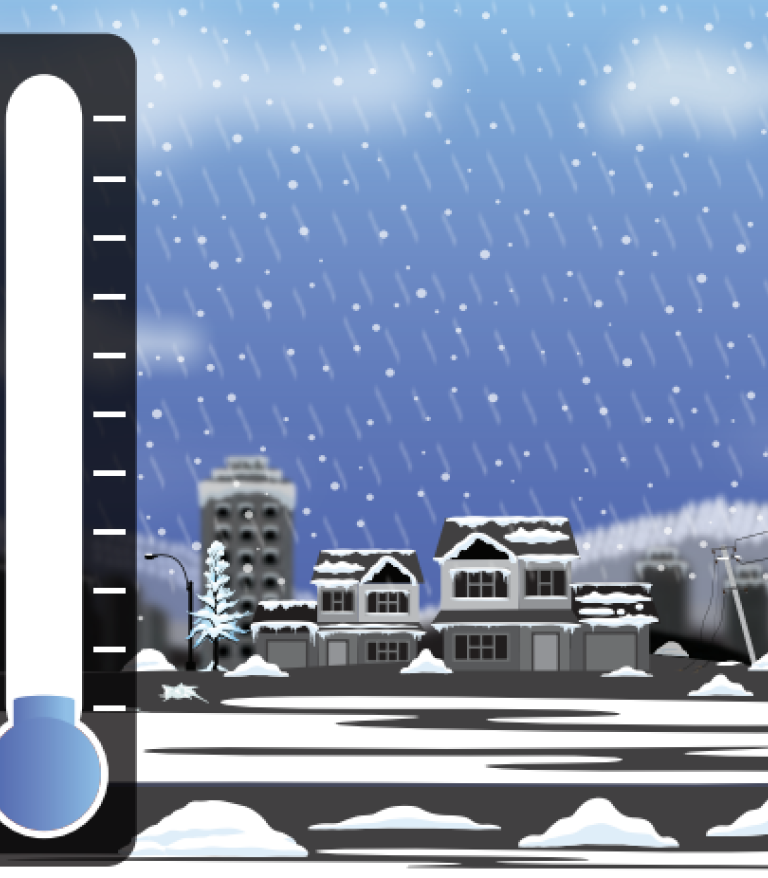
PreparedBC Severe Winter Weather and Storm Preparedness Guide
PreparedBC has developed a Severe Winter Weather and Storm Readiness Guide to help people prepare for such weather events. The booklet provides key information on the risks associated with the season and actions you can take to be prepared.
Download the preparedness guideAdditional winter weather resources
Check social media pages for updates and new services in your local area.
-
-
HealthLinkBC
Tips for staying active in winter weather
-
Health Canada
Extreme Cold Health Guide
-
Canadian Centre for Occupational Health and Safety
Safety tips for shoveling snow
-
Toward the Heart
Getting Prescriptions and Carries During Extreme Weather
-
-
-
Drive BC
Plan your route and receive up-to-date weather information
-
Centers for Disease Control and Prevention
How to stay safe during and after a winter storm.
-
Province of BC
Province of BC emergency kit checklist (Translated)
-
PreparedBC
PreparedBC planning for various hazards guides and tools
-
Technical Safety BC
Space Heater Safety Guide
-
-
-
City of Vancouver - Translated
Local winter weather Information
-
City of Richmond – Translated
Local winter weather Information
-
City of North Vancouver
Local snow and ice information
-
City of North Vancouver
Local winter weather Information
-
District of North Vancouver
Local Winter Weather Information
-
District of West Vancouver
Local winter weather Information
-
North Shore Emergency Management
Local winter weather Information
-
Bowen Island Municipality
Local winter weather Information
-
The Village of Lions Bay
Local winter weather Information
-
District of Squamish
Local winter weather Information
-
Town of Gibsons
Local winter weather Information
-
District of Sechelt
Local winter weather Information
-
City of Powell River
Local winter weather Information
-


